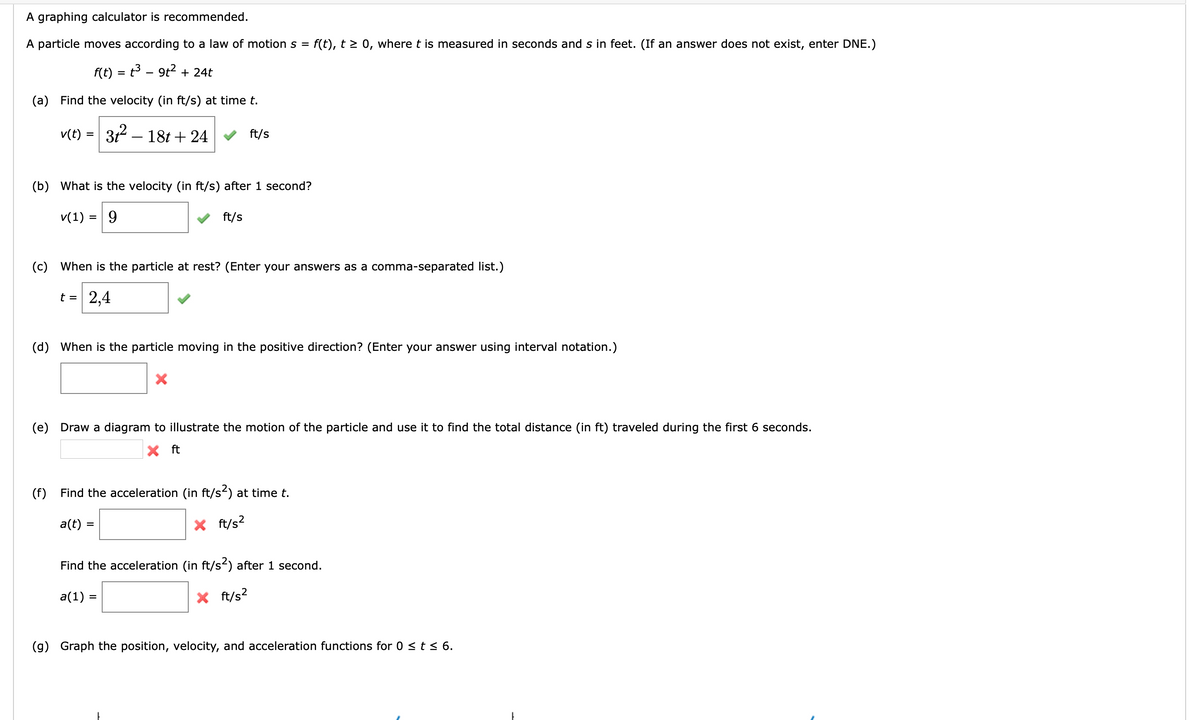A graphing calculator is recommended. A particle moves according to a law of motion s = f(t), t> 0, where t is measured in seconds and s in feet. (If an answer does not exist, enter DNE.) f(t) = t3 - 9t2 + 24t (a) Find the velocity (in ft/s) at time t. v(t) = 31 – 18t+ 24 v ft/s (b) What is the velocity (in ft/s) after 1 second? v(1) = 9 v ft/s (c) When is the particle at rest? (Enter your answers as a comma-separated list.) t = 2.4 (d) When is the particle moving in the positive direction? (Enter your answer using interval notation.) (e) Draw a diagram to illustrate the motion of the particle and use it to find the total distance (in ft) traveled during the first 6 seconds. X ft (f) Find the acceleration (in ft/s?) at time t. a(t) = X ft/s? Find the acceleration (in ft/s?) after 1 second. a(1) = x ft/s? (g) Graph the position, velocity, and acceleration functions for 0 sts 6.
A graphing calculator is recommended. A particle moves according to a law of motion s = f(t), t> 0, where t is measured in seconds and s in feet. (If an answer does not exist, enter DNE.) f(t) = t3 - 9t2 + 24t (a) Find the velocity (in ft/s) at time t. v(t) = 31 – 18t+ 24 v ft/s (b) What is the velocity (in ft/s) after 1 second? v(1) = 9 v ft/s (c) When is the particle at rest? (Enter your answers as a comma-separated list.) t = 2.4 (d) When is the particle moving in the positive direction? (Enter your answer using interval notation.) (e) Draw a diagram to illustrate the motion of the particle and use it to find the total distance (in ft) traveled during the first 6 seconds. X ft (f) Find the acceleration (in ft/s?) at time t. a(t) = X ft/s? Find the acceleration (in ft/s?) after 1 second. a(1) = x ft/s? (g) Graph the position, velocity, and acceleration functions for 0 sts 6.
Algebra & Trigonometry with Analytic Geometry
13th Edition
ISBN:9781133382119
Author:Swokowski
Publisher:Swokowski
Chapter2: Equations And Inequalities
Section2.7: More On Inequalities
Problem 44E
Related questions
Question
i just need help from d through G please

Transcribed Image Text:A graphing calculator is recommended.
A particle moves according to a law of motion s =
f(t), t > 0, where t is measured in seconds and s in feet. (If an answer does not exist, enter DNE.)
f(t) = t3 - 9t2 + 24t
(a) Find the velocity (in ft/s) at time t.
v(t) = 312 – 18t + 24
ft/s
(b) What is the velocity (in ft/s) after 1 second?
v(1) = 9
ft/s
(c) When is the particle at rest? (Enter your answers as a comma-separated list.)
t = 2,4
(d)
When is the particle moving in the positive direction? (Enter your answer using interval notation.)
(e) Draw a diagram to illustrate the motion of the particle and use it to find the total distance (in ft) traveled during the first 6 seconds.
X ft
(f)
Find the acceleration (in ft/s2) at time t.
a(t) =
X ft/s?
Find the acceleration (in ft/s2) after 1 second.
a(1) =
X ft/s?
(g) Graph the position, velocity, and acceleration functions for 0 <ts 6.
Expert Solution
This question has been solved!
Explore an expertly crafted, step-by-step solution for a thorough understanding of key concepts.
This is a popular solution!
Trending now
This is a popular solution!
Step by step
Solved in 2 steps with 1 images

Recommended textbooks for you

Algebra & Trigonometry with Analytic Geometry
Algebra
ISBN:
9781133382119
Author:
Swokowski
Publisher:
Cengage

College Algebra
Algebra
ISBN:
9781305115545
Author:
James Stewart, Lothar Redlin, Saleem Watson
Publisher:
Cengage Learning


Algebra & Trigonometry with Analytic Geometry
Algebra
ISBN:
9781133382119
Author:
Swokowski
Publisher:
Cengage

College Algebra
Algebra
ISBN:
9781305115545
Author:
James Stewart, Lothar Redlin, Saleem Watson
Publisher:
Cengage Learning

